 |
||||
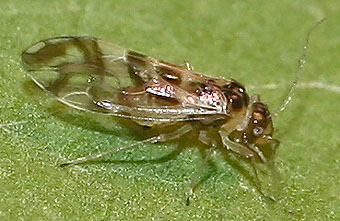 Graphopsocus cruciatus
Graphopsocus cruciatus
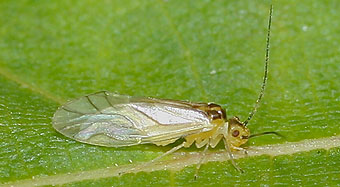 Valenzuela flavidus
Valenzuela flavidus
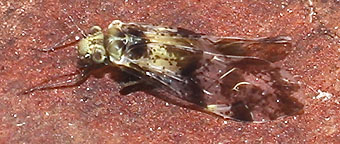 Loensia fasciata
Loensia fasciata
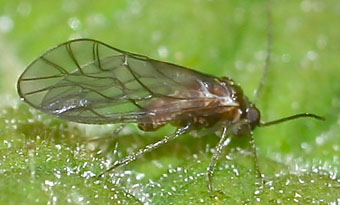 Elipsocus hyalinus
Elipsocus hyalinus
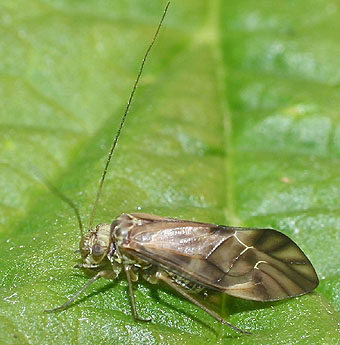 Metylophorus nebulosus
Metylophorus nebulosus
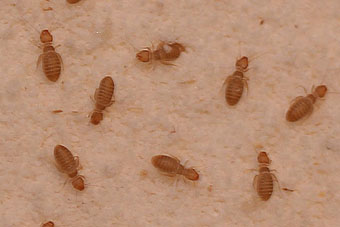 Liposcelis bostrychophila
Liposcelis bostrychophila
In an issue of Muntjac (Spring 2011, number 158) , I wrote an article entitled "Neglected Insects in Bedfordshire". My intention was that this would be the start of a series of articles in an attempt to try and stimulate further interest and recording of some of these Insect groups. In addition to giving regular updates on the progress in the recording of these I hope to provide further information about the various groups on which I am focusing.
For this article I have selected the Barkflies and Booklice that together comprise the Insect Order Psocoptera, a group that many will probably not have encountered though they are actually rather common. Nonetheless with just under 90 species of this order known in Britain only a handful have so far been recorded for Bedfordshire.
The name barkfly was only coined in 2003 by Keith Alexander as an alternative to the previously used vernacular name of barklice. As the term "lice" has such a bad press he felt a more attractive name might promote greater interest in these delightful little insects. Barkflies live outdoors whereas Booklice occur indoors, including as pests of stored food products though they are harmless to humans.
Barkflies are relatively small insects (1.5 - 7mm) that usually hold their wings in a tent-wise fashion over their abdomens rather like miniature lacewings. Some species do not have full-sized (macropterous) wings but have ones that are much reduced (brachypterous) or absent (apterous).
Useful features in recognising barkflies are the domed postclypeus (the area at the front of the head between the antennae and mouth), long filiform antennae, the simple wing venation with two ‘triangular’ cells at the tip of the forewing, and a pronounced tendency to run rather than fly away. They can be confused with jumping plant lice (psyllids) but these have very different wing venation and tend to jump if gently touched whereas barkflies will only rarely do so and might at best manage a feeble hop.
Barkflies can be found on a wide range of broad-leaved and coniferous tree species with the greatest diversity of species likely on Oak, Beech, Yew, Pine, Elder and Hawthorn. Ash, Sycamore and Lime usually have a low diversity of species. Mature trees in old parkland can be particularly productive.
Two useful techniques for collecting barkflies are:
- Beating tree branches with a stick and catching the falling insects onto a beating tray, a net or an upturned umbrella).
- Sampling of tree trunks using a large soft brush (e.g. wallpaper paste brush) and brushing down the trunk catching any specimens in a beating tray or net.
The foliage of trees represents a distinctly different niche to the bark and in particular the trunks. As a result, beating tree branches will often result in a different range of species to that obtained by sampling tree trunks.
However not all barkflies are associated with trees and searches of low vegetation, leaf litter and under stones will also occasionally yield other species. Sweep-netting, litter sieving, malaise trapping, vacuum sampling can therefore also be techniques worth trying, whilst a few species may occasionally be attracted to light, though easily overlooked as one sorts out the catch in a moth trap.
Most barkfly species can be identified without too much difficulty from external characters such as wing venation. Fortunately only very few require dissection for identification.
Many species can be identified using the National Recording Scheme website and there is also a very good Royal Entomological Society Handbook. However bear in mind that the Beds Biological Record Centre requires identifications to be verified by someone authoritative (County Recorder or higher, or on a forum with expert peer review).
I have included here some images of the species that I have recorded for Bedfordshire. There must be many more! All these have been found on more than one occasion but details of the images are given below.
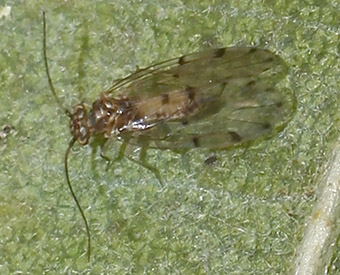
Ectopsocus petersii
- Graphopsocus cruciatus swept from Cytisus cv. garden, Clifton, Beds. 8 Oct 2010, coll. A.R. Outen conf. Keith Alexander © Alan R. Outen
- Ectopsocus petersii swept from Quercus robur, Ampthill Park, 30 Oct 2011, coll. A.R. Outen conf. Keith Alexander. © Alan R. Outen
- Valenzuela flavidus swept Tilia, Studham Middle Common, 02 Sept 2011, coll. A.R. Outen conf. Keith Alexander. © Alan R. Outen
- Loensia fasciata Stanford Wood, Beds. 19 May 2011 coll. A.R. Outen conf. Keith Alexander © Alan R. Outen
- Elipsocus hyalinus swept Quercus, Studham Middle Common 02 Sept 2011, coll. A.R. Outen det. Keith Alexander. © Alan R. Outen
- Metylophorus nebulosus swept from Oak, Clifton Bury, Beds. 29 Jun 2011, coll. A.R. Outen conf. Keith Alexander. © Alan R. Outen
- Liposcelis bostrychophila a wingless booklouse species in stored flour, Clifton, Beds, 3 September 2010, coll and det A.R. Outen. © Alan R. Outen
My thanks to Keith Alexander (National Recorder) for help with identifications.
National Barkfly Recording Scheme Web-site at www.brc.ac.uk/schemes/barkfly/introduction.htm
New T. R. Psocids Psocoptera (Booklice and barklice) 2nd edition (RES Handbook Vol 1 part 7 December 2005 ISBN: 9780901546845) Royal Entomological Society
Outen A. R. (2011) Neglected Insects in Bedfordshire. Muntjac 158